Financial Management Report on XYZ Plc (LFBM203 Assessment)
VerifiedAdded on 2023/06/08
|8
|2196
|491
Report
AI Summary
This report provides a detailed analysis of financial management concepts applied to XYZ Plc, a holding company with three distinct departments: X-Square Financial Ltd, York Manufacturing Ltd, and Zebra Investment Ltd. The report begins with an introduction to financial resource management and its importance in addressing financial planning and control complexities. The main body of the report is structured around three scenarios. Scenario 1 focuses on ratio analysis, discussing liquidity, solvency, profitability, efficiency, and market prospect ratios, and also explores sources of finance. Scenario 2 covers costing methods, advantages of costing, and Cost Volume Profit (CVP) analysis, including its advantages. Scenario 3 examines the cost of capital and investment appraisal methods, including Net Present Value (NPV), Internal Rate of Return (IRR), and payback period. The report concludes by summarizing the key findings and emphasizing the importance of managing financial resources for improving profitability and overall business value, referencing the use of financial ratios, costing techniques, and investment appraisal methods. The report also highlights the importance of external financing for business growth and development.
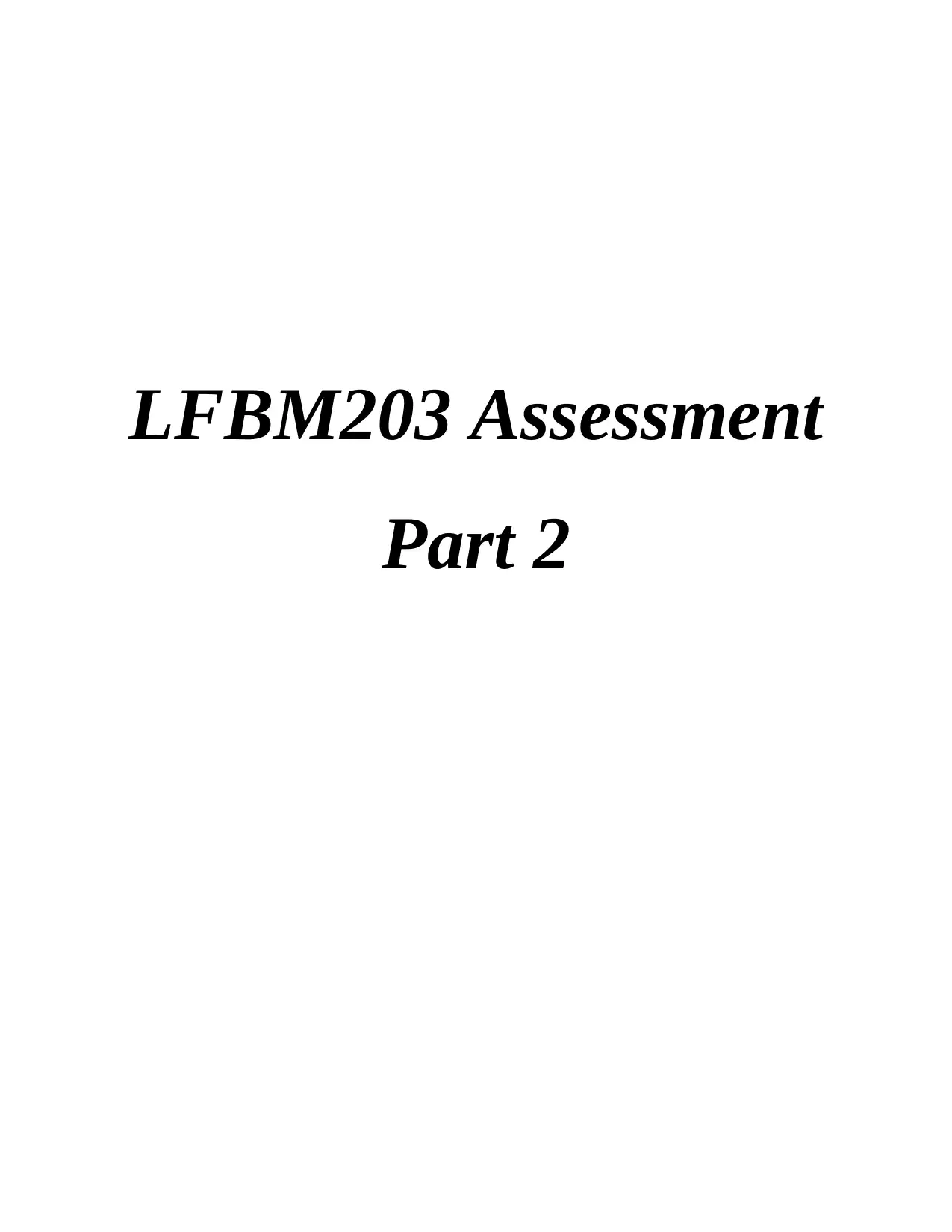
LFBM203 Assessment
Part 2
Part 2
Paraphrase This Document
Need a fresh take? Get an instant paraphrase of this document with our AI Paraphraser

Table of Contents
INTRODUCTION ..........................................................................................................................3
MAIN BODY...................................................................................................................................3
Scenario 1 Ratio analysis and Sources of Finance.................................................................3
Scenario 2 Costing and Cost volume profit (CVP) analysis..................................................5
Scenario 3 Cost of capital and Investment appraisal methods...............................................6
CONCLUSION................................................................................................................................7
REFERENCES................................................................................................................................8
INTRODUCTION ..........................................................................................................................3
MAIN BODY...................................................................................................................................3
Scenario 1 Ratio analysis and Sources of Finance.................................................................3
Scenario 2 Costing and Cost volume profit (CVP) analysis..................................................5
Scenario 3 Cost of capital and Investment appraisal methods...............................................6
CONCLUSION................................................................................................................................7
REFERENCES................................................................................................................................8
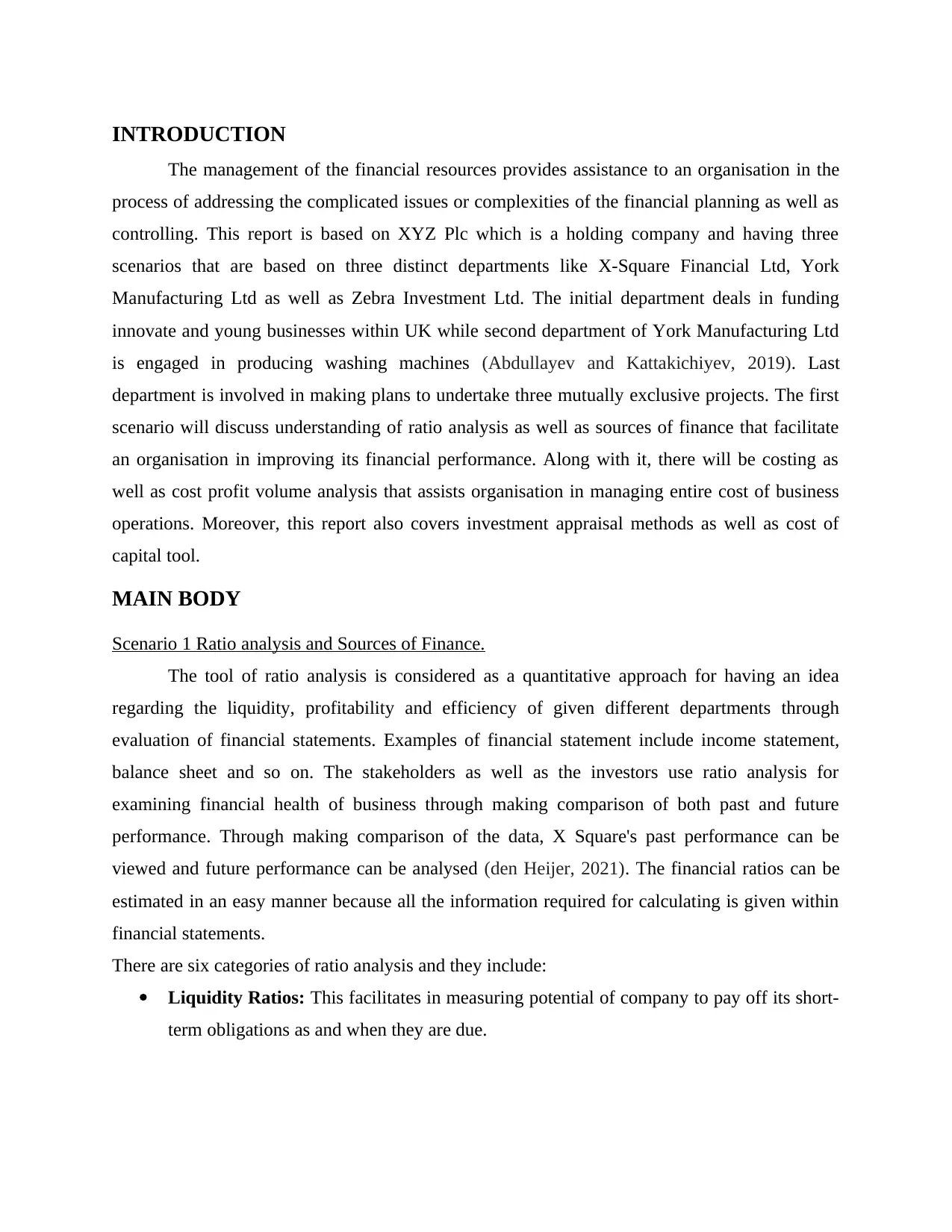
INTRODUCTION
The management of the financial resources provides assistance to an organisation in the
process of addressing the complicated issues or complexities of the financial planning as well as
controlling. This report is based on XYZ Plc which is a holding company and having three
scenarios that are based on three distinct departments like X-Square Financial Ltd, York
Manufacturing Ltd as well as Zebra Investment Ltd. The initial department deals in funding
innovate and young businesses within UK while second department of York Manufacturing Ltd
is engaged in producing washing machines (Abdullayev and Kattakichiyev, 2019). Last
department is involved in making plans to undertake three mutually exclusive projects. The first
scenario will discuss understanding of ratio analysis as well as sources of finance that facilitate
an organisation in improving its financial performance. Along with it, there will be costing as
well as cost profit volume analysis that assists organisation in managing entire cost of business
operations. Moreover, this report also covers investment appraisal methods as well as cost of
capital tool.
MAIN BODY
Scenario 1 Ratio analysis and Sources of Finance.
The tool of ratio analysis is considered as a quantitative approach for having an idea
regarding the liquidity, profitability and efficiency of given different departments through
evaluation of financial statements. Examples of financial statement include income statement,
balance sheet and so on. The stakeholders as well as the investors use ratio analysis for
examining financial health of business through making comparison of both past and future
performance. Through making comparison of the data, X Square's past performance can be
viewed and future performance can be analysed (den Heijer, 2021). The financial ratios can be
estimated in an easy manner because all the information required for calculating is given within
financial statements.
There are six categories of ratio analysis and they include:
Liquidity Ratios: This facilitates in measuring potential of company to pay off its short-
term obligations as and when they are due.
The management of the financial resources provides assistance to an organisation in the
process of addressing the complicated issues or complexities of the financial planning as well as
controlling. This report is based on XYZ Plc which is a holding company and having three
scenarios that are based on three distinct departments like X-Square Financial Ltd, York
Manufacturing Ltd as well as Zebra Investment Ltd. The initial department deals in funding
innovate and young businesses within UK while second department of York Manufacturing Ltd
is engaged in producing washing machines (Abdullayev and Kattakichiyev, 2019). Last
department is involved in making plans to undertake three mutually exclusive projects. The first
scenario will discuss understanding of ratio analysis as well as sources of finance that facilitate
an organisation in improving its financial performance. Along with it, there will be costing as
well as cost profit volume analysis that assists organisation in managing entire cost of business
operations. Moreover, this report also covers investment appraisal methods as well as cost of
capital tool.
MAIN BODY
Scenario 1 Ratio analysis and Sources of Finance.
The tool of ratio analysis is considered as a quantitative approach for having an idea
regarding the liquidity, profitability and efficiency of given different departments through
evaluation of financial statements. Examples of financial statement include income statement,
balance sheet and so on. The stakeholders as well as the investors use ratio analysis for
examining financial health of business through making comparison of both past and future
performance. Through making comparison of the data, X Square's past performance can be
viewed and future performance can be analysed (den Heijer, 2021). The financial ratios can be
estimated in an easy manner because all the information required for calculating is given within
financial statements.
There are six categories of ratio analysis and they include:
Liquidity Ratios: This facilitates in measuring potential of company to pay off its short-
term obligations as and when they are due.
⊘ This is a preview!⊘
Do you want full access?
Subscribe today to unlock all pages.

Trusted by 1+ million students worldwide

Solvency Ratios: These ratios can be used for comparing debt of an organisation wit its
assets, earnings as well as equity for the purpose of identification of capability of firm for
its long-term sustainability.
Profitability Ratios: Such ratios states the amount of potential hold by firm for
generating profits through daily business operations.
Efficiency Ratios: Such ratios are used to examine how well an organisation uses its
assets as well as liabilities for earning and maximising level of profitability (Filin and
et.al., 2020).
Converge Ratios: This facilitates in calculating ability for making payment of interest
and debts that are taken.
Market Prospect Ratios: Such types of ratios are the most commonly used ratios.
Investors make us of these ratios for forecasting performance as well as earnings of the
future.
Those businesses which are successful analyse performance of organisation in a regular
way and also compare it with rivalries. Such comparisons are very significant for success and
initiation of future business operations. Through making analysis of these financial ratios, an
organisation can easily identify its loopholes or weak areas of the business. This permits in the
process of tracking actual performance with the standard one for recognising deviations as well
as change policies according to these. Sustainable Growth Rate (SGR) helps organisations in
attaining without falling into issues and is very crucial for business. There is powerful
relationship among organisational performance and financial sources of the company. In case if
X Square has sufficient capital and credit, then it will hinder the growth, success and
performance of organisation as a whole (Kolomytseva, Medvedeva and Kolomiets, 2019). As it
will save them from acquiring techniques that can make it efficient as well as productive. In
addition to it, in case when organisation has access to funds then each perspective of firm either
management or accounting will implement best and effective practices along with improving
business performance. External financing also facilitates in easy flow of cash and generating
additional income. It also provide assistance in providing training and development of the single
individuals. It is confirmed through a survey, that an organisation is preferred to take external
funding for the purpose of accomplishing withdrawals as well as savings along with management
of expenditures and assets.
assets, earnings as well as equity for the purpose of identification of capability of firm for
its long-term sustainability.
Profitability Ratios: Such ratios states the amount of potential hold by firm for
generating profits through daily business operations.
Efficiency Ratios: Such ratios are used to examine how well an organisation uses its
assets as well as liabilities for earning and maximising level of profitability (Filin and
et.al., 2020).
Converge Ratios: This facilitates in calculating ability for making payment of interest
and debts that are taken.
Market Prospect Ratios: Such types of ratios are the most commonly used ratios.
Investors make us of these ratios for forecasting performance as well as earnings of the
future.
Those businesses which are successful analyse performance of organisation in a regular
way and also compare it with rivalries. Such comparisons are very significant for success and
initiation of future business operations. Through making analysis of these financial ratios, an
organisation can easily identify its loopholes or weak areas of the business. This permits in the
process of tracking actual performance with the standard one for recognising deviations as well
as change policies according to these. Sustainable Growth Rate (SGR) helps organisations in
attaining without falling into issues and is very crucial for business. There is powerful
relationship among organisational performance and financial sources of the company. In case if
X Square has sufficient capital and credit, then it will hinder the growth, success and
performance of organisation as a whole (Kolomytseva, Medvedeva and Kolomiets, 2019). As it
will save them from acquiring techniques that can make it efficient as well as productive. In
addition to it, in case when organisation has access to funds then each perspective of firm either
management or accounting will implement best and effective practices along with improving
business performance. External financing also facilitates in easy flow of cash and generating
additional income. It also provide assistance in providing training and development of the single
individuals. It is confirmed through a survey, that an organisation is preferred to take external
funding for the purpose of accomplishing withdrawals as well as savings along with management
of expenditures and assets.
Paraphrase This Document
Need a fresh take? Get an instant paraphrase of this document with our AI Paraphraser
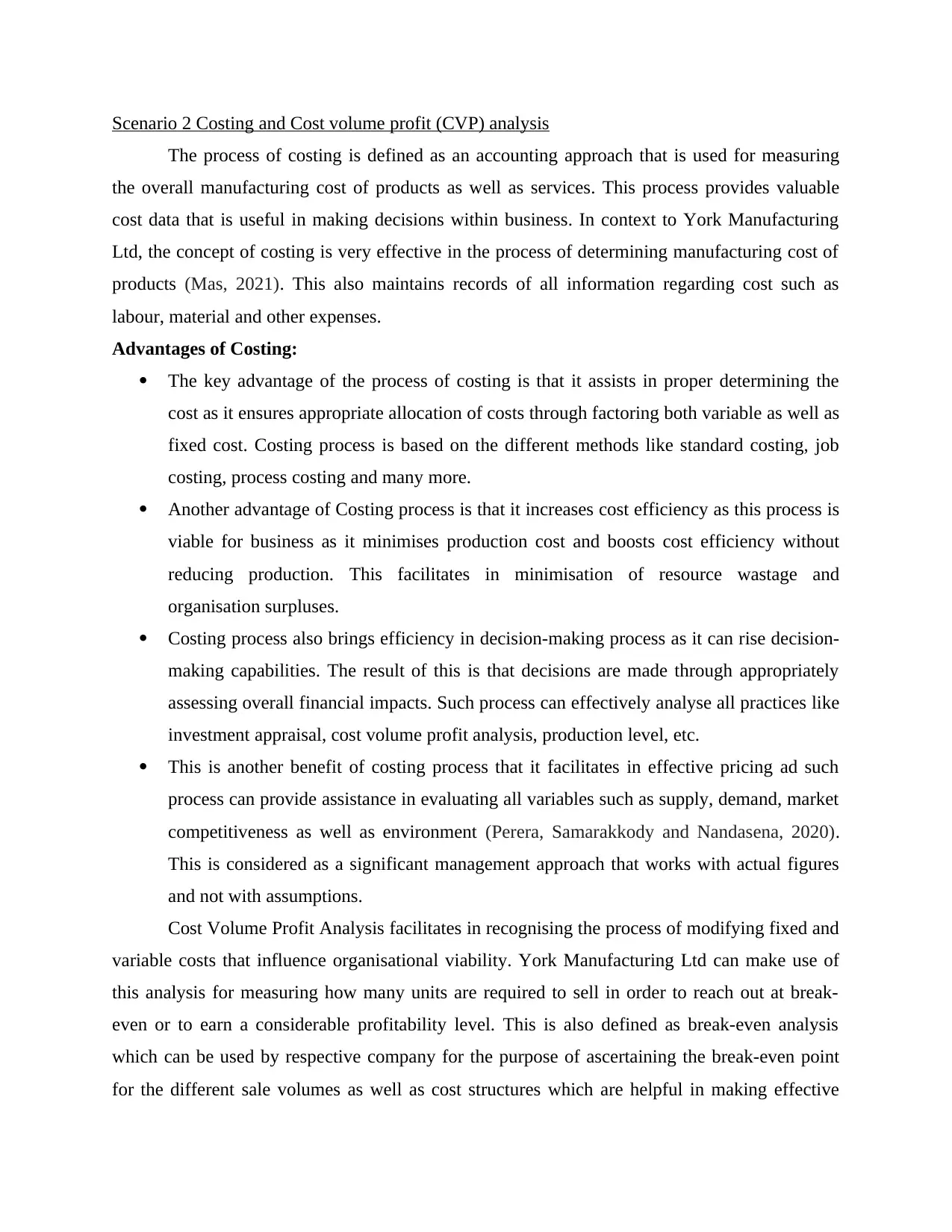
Scenario 2 Costing and Cost volume profit (CVP) analysis
The process of costing is defined as an accounting approach that is used for measuring
the overall manufacturing cost of products as well as services. This process provides valuable
cost data that is useful in making decisions within business. In context to York Manufacturing
Ltd, the concept of costing is very effective in the process of determining manufacturing cost of
products (Mas, 2021). This also maintains records of all information regarding cost such as
labour, material and other expenses.
Advantages of Costing:
The key advantage of the process of costing is that it assists in proper determining the
cost as it ensures appropriate allocation of costs through factoring both variable as well as
fixed cost. Costing process is based on the different methods like standard costing, job
costing, process costing and many more.
Another advantage of Costing process is that it increases cost efficiency as this process is
viable for business as it minimises production cost and boosts cost efficiency without
reducing production. This facilitates in minimisation of resource wastage and
organisation surpluses.
Costing process also brings efficiency in decision-making process as it can rise decision-
making capabilities. The result of this is that decisions are made through appropriately
assessing overall financial impacts. Such process can effectively analyse all practices like
investment appraisal, cost volume profit analysis, production level, etc.
This is another benefit of costing process that it facilitates in effective pricing ad such
process can provide assistance in evaluating all variables such as supply, demand, market
competitiveness as well as environment (Perera, Samarakkody and Nandasena, 2020).
This is considered as a significant management approach that works with actual figures
and not with assumptions.
Cost Volume Profit Analysis facilitates in recognising the process of modifying fixed and
variable costs that influence organisational viability. York Manufacturing Ltd can make use of
this analysis for measuring how many units are required to sell in order to reach out at break-
even or to earn a considerable profitability level. This is also defined as break-even analysis
which can be used by respective company for the purpose of ascertaining the break-even point
for the different sale volumes as well as cost structures which are helpful in making effective
The process of costing is defined as an accounting approach that is used for measuring
the overall manufacturing cost of products as well as services. This process provides valuable
cost data that is useful in making decisions within business. In context to York Manufacturing
Ltd, the concept of costing is very effective in the process of determining manufacturing cost of
products (Mas, 2021). This also maintains records of all information regarding cost such as
labour, material and other expenses.
Advantages of Costing:
The key advantage of the process of costing is that it assists in proper determining the
cost as it ensures appropriate allocation of costs through factoring both variable as well as
fixed cost. Costing process is based on the different methods like standard costing, job
costing, process costing and many more.
Another advantage of Costing process is that it increases cost efficiency as this process is
viable for business as it minimises production cost and boosts cost efficiency without
reducing production. This facilitates in minimisation of resource wastage and
organisation surpluses.
Costing process also brings efficiency in decision-making process as it can rise decision-
making capabilities. The result of this is that decisions are made through appropriately
assessing overall financial impacts. Such process can effectively analyse all practices like
investment appraisal, cost volume profit analysis, production level, etc.
This is another benefit of costing process that it facilitates in effective pricing ad such
process can provide assistance in evaluating all variables such as supply, demand, market
competitiveness as well as environment (Perera, Samarakkody and Nandasena, 2020).
This is considered as a significant management approach that works with actual figures
and not with assumptions.
Cost Volume Profit Analysis facilitates in recognising the process of modifying fixed and
variable costs that influence organisational viability. York Manufacturing Ltd can make use of
this analysis for measuring how many units are required to sell in order to reach out at break-
even or to earn a considerable profitability level. This is also defined as break-even analysis
which can be used by respective company for the purpose of ascertaining the break-even point
for the different sale volumes as well as cost structures which are helpful in making effective
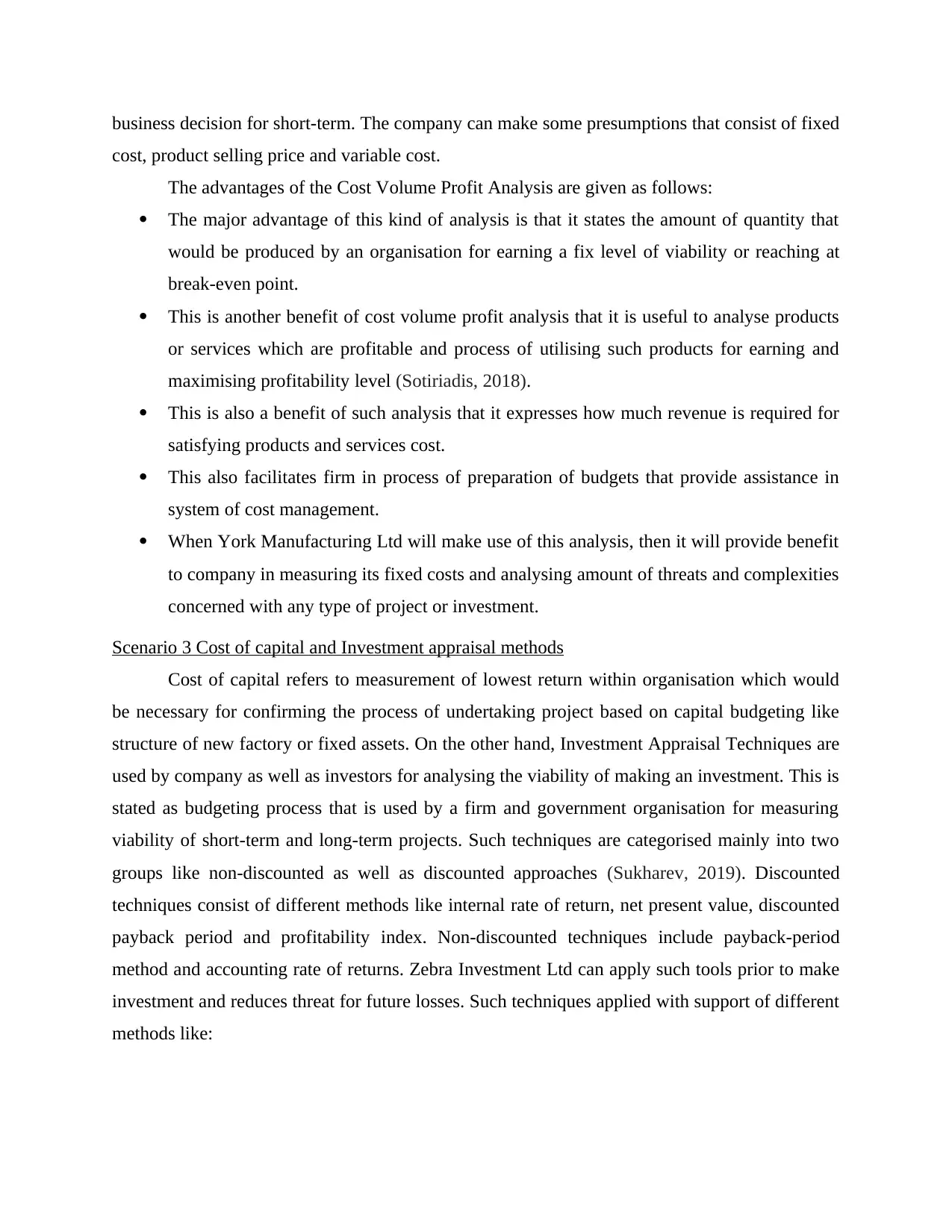
business decision for short-term. The company can make some presumptions that consist of fixed
cost, product selling price and variable cost.
The advantages of the Cost Volume Profit Analysis are given as follows:
The major advantage of this kind of analysis is that it states the amount of quantity that
would be produced by an organisation for earning a fix level of viability or reaching at
break-even point.
This is another benefit of cost volume profit analysis that it is useful to analyse products
or services which are profitable and process of utilising such products for earning and
maximising profitability level (Sotiriadis, 2018).
This is also a benefit of such analysis that it expresses how much revenue is required for
satisfying products and services cost.
This also facilitates firm in process of preparation of budgets that provide assistance in
system of cost management.
When York Manufacturing Ltd will make use of this analysis, then it will provide benefit
to company in measuring its fixed costs and analysing amount of threats and complexities
concerned with any type of project or investment.
Scenario 3 Cost of capital and Investment appraisal methods
Cost of capital refers to measurement of lowest return within organisation which would
be necessary for confirming the process of undertaking project based on capital budgeting like
structure of new factory or fixed assets. On the other hand, Investment Appraisal Techniques are
used by company as well as investors for analysing the viability of making an investment. This is
stated as budgeting process that is used by a firm and government organisation for measuring
viability of short-term and long-term projects. Such techniques are categorised mainly into two
groups like non-discounted as well as discounted approaches (Sukharev, 2019). Discounted
techniques consist of different methods like internal rate of return, net present value, discounted
payback period and profitability index. Non-discounted techniques include payback-period
method and accounting rate of returns. Zebra Investment Ltd can apply such tools prior to make
investment and reduces threat for future losses. Such techniques applied with support of different
methods like:
cost, product selling price and variable cost.
The advantages of the Cost Volume Profit Analysis are given as follows:
The major advantage of this kind of analysis is that it states the amount of quantity that
would be produced by an organisation for earning a fix level of viability or reaching at
break-even point.
This is another benefit of cost volume profit analysis that it is useful to analyse products
or services which are profitable and process of utilising such products for earning and
maximising profitability level (Sotiriadis, 2018).
This is also a benefit of such analysis that it expresses how much revenue is required for
satisfying products and services cost.
This also facilitates firm in process of preparation of budgets that provide assistance in
system of cost management.
When York Manufacturing Ltd will make use of this analysis, then it will provide benefit
to company in measuring its fixed costs and analysing amount of threats and complexities
concerned with any type of project or investment.
Scenario 3 Cost of capital and Investment appraisal methods
Cost of capital refers to measurement of lowest return within organisation which would
be necessary for confirming the process of undertaking project based on capital budgeting like
structure of new factory or fixed assets. On the other hand, Investment Appraisal Techniques are
used by company as well as investors for analysing the viability of making an investment. This is
stated as budgeting process that is used by a firm and government organisation for measuring
viability of short-term and long-term projects. Such techniques are categorised mainly into two
groups like non-discounted as well as discounted approaches (Sukharev, 2019). Discounted
techniques consist of different methods like internal rate of return, net present value, discounted
payback period and profitability index. Non-discounted techniques include payback-period
method and accounting rate of returns. Zebra Investment Ltd can apply such tools prior to make
investment and reduces threat for future losses. Such techniques applied with support of different
methods like:
⊘ This is a preview!⊘
Do you want full access?
Subscribe today to unlock all pages.

Trusted by 1+ million students worldwide
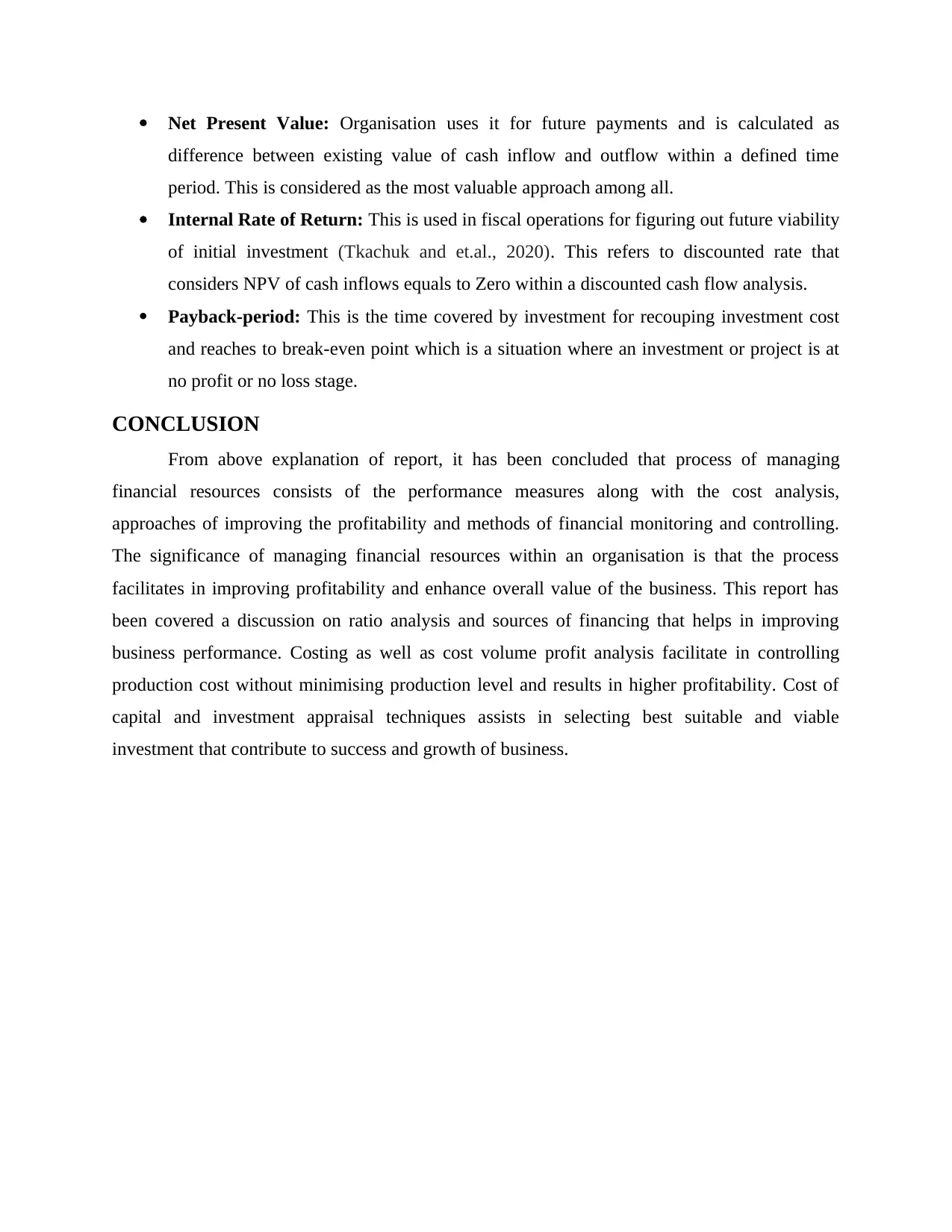
Net Present Value: Organisation uses it for future payments and is calculated as
difference between existing value of cash inflow and outflow within a defined time
period. This is considered as the most valuable approach among all.
Internal Rate of Return: This is used in fiscal operations for figuring out future viability
of initial investment (Tkachuk and et.al., 2020). This refers to discounted rate that
considers NPV of cash inflows equals to Zero within a discounted cash flow analysis.
Payback-period: This is the time covered by investment for recouping investment cost
and reaches to break-even point which is a situation where an investment or project is at
no profit or no loss stage.
CONCLUSION
From above explanation of report, it has been concluded that process of managing
financial resources consists of the performance measures along with the cost analysis,
approaches of improving the profitability and methods of financial monitoring and controlling.
The significance of managing financial resources within an organisation is that the process
facilitates in improving profitability and enhance overall value of the business. This report has
been covered a discussion on ratio analysis and sources of financing that helps in improving
business performance. Costing as well as cost volume profit analysis facilitate in controlling
production cost without minimising production level and results in higher profitability. Cost of
capital and investment appraisal techniques assists in selecting best suitable and viable
investment that contribute to success and growth of business.
difference between existing value of cash inflow and outflow within a defined time
period. This is considered as the most valuable approach among all.
Internal Rate of Return: This is used in fiscal operations for figuring out future viability
of initial investment (Tkachuk and et.al., 2020). This refers to discounted rate that
considers NPV of cash inflows equals to Zero within a discounted cash flow analysis.
Payback-period: This is the time covered by investment for recouping investment cost
and reaches to break-even point which is a situation where an investment or project is at
no profit or no loss stage.
CONCLUSION
From above explanation of report, it has been concluded that process of managing
financial resources consists of the performance measures along with the cost analysis,
approaches of improving the profitability and methods of financial monitoring and controlling.
The significance of managing financial resources within an organisation is that the process
facilitates in improving profitability and enhance overall value of the business. This report has
been covered a discussion on ratio analysis and sources of financing that helps in improving
business performance. Costing as well as cost volume profit analysis facilitate in controlling
production cost without minimising production level and results in higher profitability. Cost of
capital and investment appraisal techniques assists in selecting best suitable and viable
investment that contribute to success and growth of business.
Paraphrase This Document
Need a fresh take? Get an instant paraphrase of this document with our AI Paraphraser
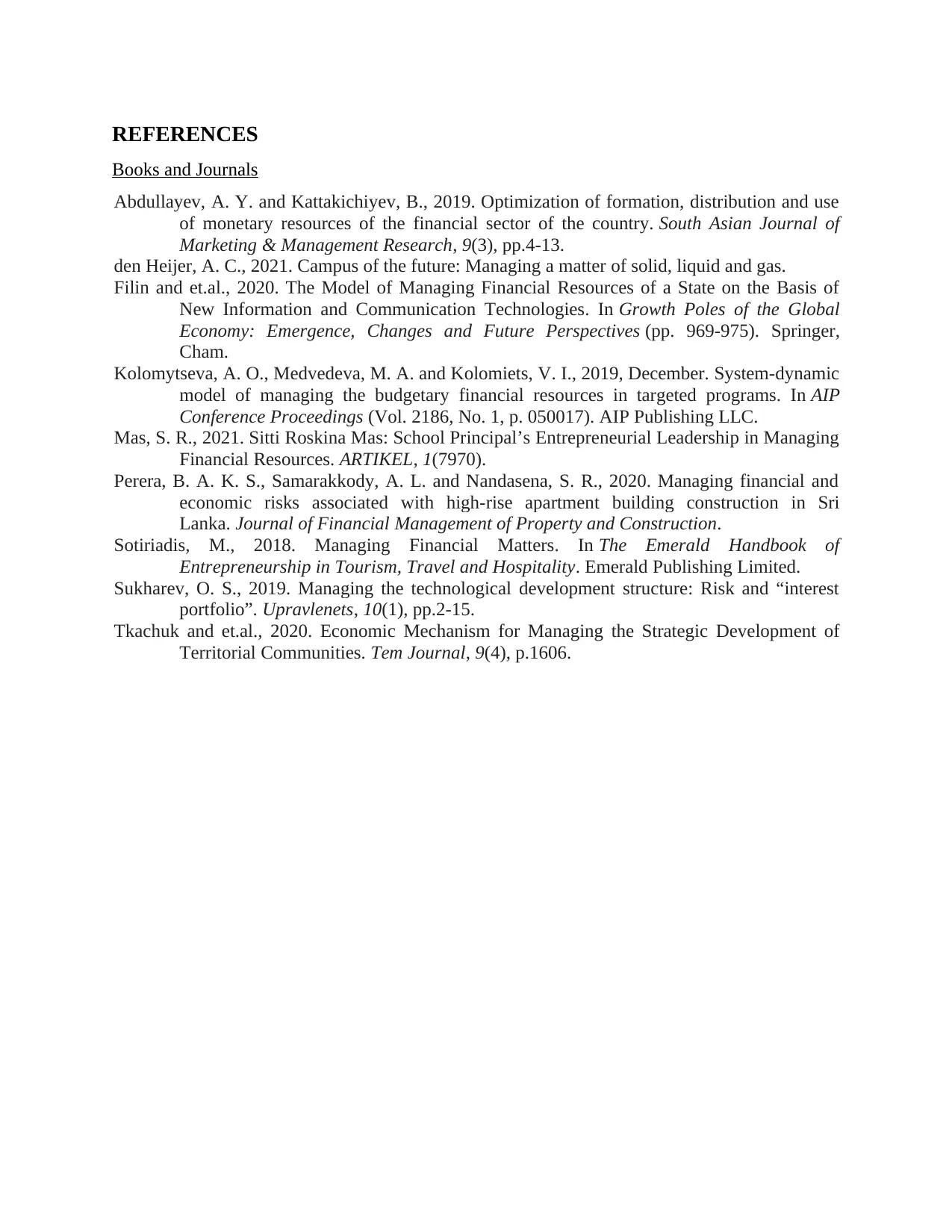
REFERENCES
Books and Journals
Abdullayev, A. Y. and Kattakichiyev, B., 2019. Optimization of formation, distribution and use
of monetary resources of the financial sector of the country. South Asian Journal of
Marketing & Management Research, 9(3), pp.4-13.
den Heijer, A. C., 2021. Campus of the future: Managing a matter of solid, liquid and gas.
Filin and et.al., 2020. The Model of Managing Financial Resources of a State on the Basis of
New Information and Communication Technologies. In Growth Poles of the Global
Economy: Emergence, Changes and Future Perspectives (pp. 969-975). Springer,
Cham.
Kolomytseva, A. O., Medvedeva, M. A. and Kolomiets, V. I., 2019, December. System-dynamic
model of managing the budgetary financial resources in targeted programs. In AIP
Conference Proceedings (Vol. 2186, No. 1, p. 050017). AIP Publishing LLC.
Mas, S. R., 2021. Sitti Roskina Mas: School Principal’s Entrepreneurial Leadership in Managing
Financial Resources. ARTIKEL, 1(7970).
Perera, B. A. K. S., Samarakkody, A. L. and Nandasena, S. R., 2020. Managing financial and
economic risks associated with high-rise apartment building construction in Sri
Lanka. Journal of Financial Management of Property and Construction.
Sotiriadis, M., 2018. Managing Financial Matters. In The Emerald Handbook of
Entrepreneurship in Tourism, Travel and Hospitality. Emerald Publishing Limited.
Sukharev, O. S., 2019. Managing the technological development structure: Risk and “interest
portfolio”. Upravlenets, 10(1), pp.2-15.
Tkachuk and et.al., 2020. Economic Mechanism for Managing the Strategic Development of
Territorial Communities. Tem Journal, 9(4), p.1606.
Books and Journals
Abdullayev, A. Y. and Kattakichiyev, B., 2019. Optimization of formation, distribution and use
of monetary resources of the financial sector of the country. South Asian Journal of
Marketing & Management Research, 9(3), pp.4-13.
den Heijer, A. C., 2021. Campus of the future: Managing a matter of solid, liquid and gas.
Filin and et.al., 2020. The Model of Managing Financial Resources of a State on the Basis of
New Information and Communication Technologies. In Growth Poles of the Global
Economy: Emergence, Changes and Future Perspectives (pp. 969-975). Springer,
Cham.
Kolomytseva, A. O., Medvedeva, M. A. and Kolomiets, V. I., 2019, December. System-dynamic
model of managing the budgetary financial resources in targeted programs. In AIP
Conference Proceedings (Vol. 2186, No. 1, p. 050017). AIP Publishing LLC.
Mas, S. R., 2021. Sitti Roskina Mas: School Principal’s Entrepreneurial Leadership in Managing
Financial Resources. ARTIKEL, 1(7970).
Perera, B. A. K. S., Samarakkody, A. L. and Nandasena, S. R., 2020. Managing financial and
economic risks associated with high-rise apartment building construction in Sri
Lanka. Journal of Financial Management of Property and Construction.
Sotiriadis, M., 2018. Managing Financial Matters. In The Emerald Handbook of
Entrepreneurship in Tourism, Travel and Hospitality. Emerald Publishing Limited.
Sukharev, O. S., 2019. Managing the technological development structure: Risk and “interest
portfolio”. Upravlenets, 10(1), pp.2-15.
Tkachuk and et.al., 2020. Economic Mechanism for Managing the Strategic Development of
Territorial Communities. Tem Journal, 9(4), p.1606.
1 out of 8
Related Documents
Your All-in-One AI-Powered Toolkit for Academic Success.
+13062052269
info@desklib.com
Available 24*7 on WhatsApp / Email
![[object Object]](/_next/static/media/star-bottom.7253800d.svg)
Unlock your academic potential
Copyright © 2020–2025 A2Z Services. All Rights Reserved. Developed and managed by ZUCOL.




